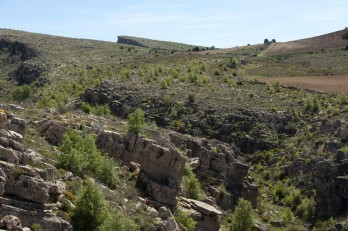Hocino Ravine
Example of restoration after a fire

Hocino Ravine
Dirección
Hocino Ravine
GPS
40.938689032206, -2.2795087737767
Hocino Ravine
This ravine is located in the locality of Riba de Saelices and in itself represented a place of great importance in terms of the conservation of diversity. Inside it was home to a marvellous mixed forest of gall oaks, holm oaks and junipers, but without any doubt we can say that what gave it that extraordinary value is the marvellous forest of 120 Yew treesThe ravines, many of which are hundreds of years old, occupy an area of 10 hectares of ravine, which were completely devastated by the fire, which in 2005 devoured 10,350 hectares of the Upper Tagus Natural Park and bordering areas of special value and protection.
Since then, a joint project from forest restorationwith the aim of re-establishing this marvellous ravine, its weaving mill and all the ecological values associated with it, such as the fauna the flora or the recovery of the devastated ground.
Of the 120 yew trees that populated the yew grove of the Hocino ravine, only one specimen survived The tree, of which, already in 2005, several cuttings were made, 35 of which have been planted 15 years later, in January 2021, in Riba de Saelices in various parts of the village. In addition to these, we must add the 140 specimens that are already planted at the Hocino Ravinefighting for his life.
The total number of yew trees to be replanted amounts to 250It is estimated that about half of them will survive, as this tree has serious difficulties in establishing itself through artificial repopulation, which is compounded by the poor state of the soil after the fire.
In addition to recovering the weaving mill, another 250 specimens of other species such as ash trees, willows, hawthorns, hawthorns, gall oaks and junipers also take their place again in the Hocino, accompanied by several nesting boxes to encourage birds to come closer and thus contribute to the dispersal of seeds, and to recover in a simple way, in addition to the Tejera, the whole group of trees and the herbaceous and plant cover that accompanies it.
El Tejo
The yew is a species native to mountainous areas with a cool and humid environment and prefers limestone soils. In Castilla la Mancha, this is a species of special interest and protection. Under optimum conditions it can reach a height of 20 metres and up to diameters of up to 1.5 metresbut if there is one thing that stands out it is its longevity, living up to 2000 yearsThis is why in many cultures, this tree is considered more sacred than earthly.
Nearly all parts of the tree are rich in toxic alkaloids, which, if ingested, can lead to death. All this and more means that, when we talk about the Yew, we cannot forget its sacred character since Celtic times, venerated thanks to its extraordinary longevity, which makes it seem immortal.
Christianity, incorporated it as symbol of life and death and because of its longevity it is also a symbol of eternity. In some places, as for example in Asturias, it is still common to find it planted next to hermitages, churches or cemeteries, as a symbol also of eternity. transition from life to death.


